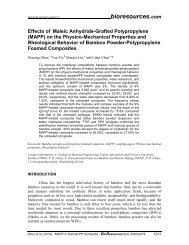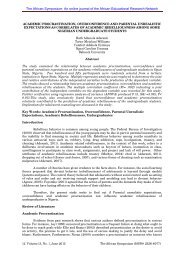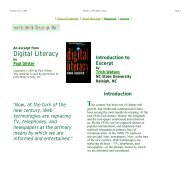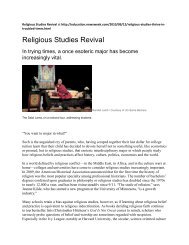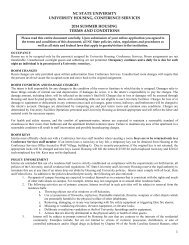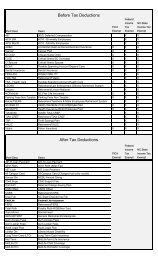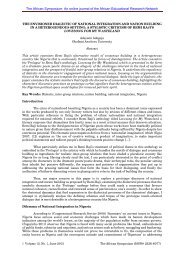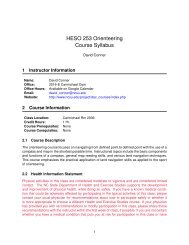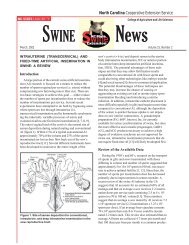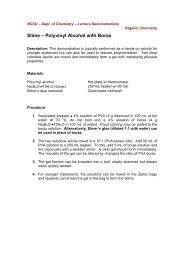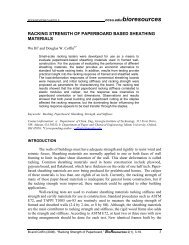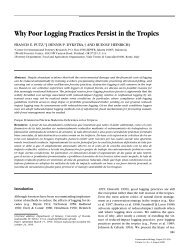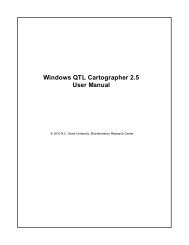Faculty Members' Views on the Usefulness of Various Assessments
Faculty Members' Views on the Usefulness of Various Assessments
Faculty Members' Views on the Usefulness of Various Assessments
Create successful ePaper yourself
Turn your PDF publications into a flip-book with our unique Google optimized e-Paper software.
<str<strong>on</strong>g>Faculty</str<strong>on</strong>g> Members’<br />
<str<strong>on</strong>g>Views</str<strong>on</strong>g> <strong>on</strong> <strong>the</strong><br />
<strong>Usefulness</strong> <strong>of</strong><br />
<strong>Various</strong><br />
<strong>Assessments</strong><br />
Jeremy Penn,<br />
Ph.D.<br />
jpenn3@unl.edu
<str<strong>on</strong>g>Faculty</str<strong>on</strong>g> members<br />
“I have sometimes thought <strong>of</strong> [<strong>the</strong><br />
University] as a series <strong>of</strong> individual<br />
Office <strong>of</strong> Undergraduate Studies<br />
faculty entrepreneurs held toge<strong>the</strong>r by a<br />
comm<strong>on</strong> grievance over parking” (Kerr,<br />
1964).
Call to acti<strong>on</strong><br />
Office <strong>of</strong> Undergraduate Studies<br />
“…every American will need to get more than a<br />
high school diploma…That is why we will<br />
provide <strong>the</strong> support necessary for you to<br />
complete college and meet a new goal: by<br />
2020, America will <strong>on</strong>ce again have <strong>the</strong><br />
highest proporti<strong>on</strong> <strong>of</strong> college graduates in <strong>the</strong><br />
world.” (President Obama, Address to Joint<br />
Sessi<strong>on</strong> <strong>of</strong> C<strong>on</strong>gress, February 24, 2009)
Improvement efforts<br />
• Internati<strong>on</strong>al<br />
• Federal Government<br />
• State Governments<br />
• Testing companies<br />
• C<strong>on</strong>sortia <strong>of</strong> instituti<strong>on</strong>s<br />
• O<strong>the</strong>r agencies<br />
• Instituti<strong>on</strong>s <strong>the</strong>mselves<br />
Office <strong>of</strong> Undergraduate Studies
<str<strong>on</strong>g>Faculty</str<strong>on</strong>g> involvement<br />
Office <strong>of</strong> Undergraduate Studies<br />
• Tends to be limited (Banta, 2002; Blackburn &<br />
Lawrence, 1995; Bok, 2006; Watty, 2003; Wergin &<br />
Swingen, 2000)<br />
However:<br />
• <str<strong>on</strong>g>Faculty</str<strong>on</strong>g> members are committed to quality<br />
(Anders<strong>on</strong>, 2006)<br />
• <str<strong>on</strong>g>Faculty</str<strong>on</strong>g> members give more effort to instituti<strong>on</strong>al<br />
service than <strong>the</strong>y believe administrators wanted<br />
(Blackburn & Lawrence, 1995)
Purpose<br />
Office <strong>of</strong> Undergraduate Studies<br />
• Learn more about faculty members’ views <strong>on</strong><br />
assessment instruments<br />
• Find ways to get faculty members more involved in<br />
improvement efforts<br />
– Ensure <strong>the</strong> success <strong>of</strong> those efforts
Explanatory mixed methods case study<br />
research design<br />
C<strong>on</strong>ceptualizati<strong>on</strong><br />
Stage<br />
Quantitative<br />
Methods Stage<br />
Quantitative<br />
Data Analysis<br />
Quantitative<br />
Inferences<br />
Meta-<br />
Inferences<br />
C<strong>on</strong>ceptualizati<strong>on</strong><br />
Stage<br />
Qualitative<br />
Methods Stage<br />
Qualitative<br />
Data Analysis<br />
Qualitative<br />
Inferences<br />
Office <strong>of</strong> Undergraduate Studies<br />
Teddlie & Tashakkori, 2006
Quantitative methods<br />
• Survey based <strong>on</strong> prior research<br />
• Pilot study<br />
• Stratified random sample from a single large<br />
research university (~1400 faculty members)<br />
– <str<strong>on</strong>g>Faculty</str<strong>on</strong>g> members who had not taught an<br />
undergraduate course in last 2 years were<br />
removed<br />
• Effective resp<strong>on</strong>se rate = 39% (216 completed<br />
surveys)<br />
Office <strong>of</strong> Undergraduate Studies
Qualitative methods<br />
• Multicase study <strong>of</strong> 5 teaching award winners<br />
• Two tape recorded hour-l<strong>on</strong>g interviews<br />
• Multiple observati<strong>on</strong>s <strong>of</strong> teaching between<br />
interviews<br />
Office <strong>of</strong> Undergraduate Studies
Outline<br />
• Data <strong>on</strong> assessment measures<br />
– Quantitative and Qualitative findings<br />
• Data <strong>on</strong> faculty members<br />
– Quantitative and Qualitative findings<br />
• Summary and discussi<strong>on</strong><br />
Office <strong>of</strong> Undergraduate Studies
Assessment measures<br />
Alumni surveys<br />
Employment rates<br />
Enrollment numbers<br />
Graduati<strong>on</strong> rates<br />
Informal c<strong>on</strong>versati<strong>on</strong>s with o<strong>the</strong>r faculty members<br />
Informal c<strong>on</strong>versati<strong>on</strong>s with students<br />
Nati<strong>on</strong>al measures (e.g., NSSE, CLA, GRE, etc.)<br />
Reviews by external experts<br />
Standardized tests or licensure exams<br />
Students’ course evaluati<strong>on</strong>s<br />
Summaries <strong>of</strong> locally developed assessments<br />
U.S. News and World Report rankings<br />
Office <strong>of</strong> Undergraduate Studies
Results: Mean rating <strong>of</strong> usefulness <strong>of</strong><br />
measures <strong>of</strong> teaching and learning<br />
Weighted n = 1062 M SD SE<br />
Informal c<strong>on</strong>versati<strong>on</strong>s with students 5.53 .63 .02<br />
Informal c<strong>on</strong>versati<strong>on</strong>s with o<strong>the</strong>r faculty members 5.20 .86 .03<br />
Students’ course evaluati<strong>on</strong>s 4.75 1.09 .03<br />
Employment rates 4.27 1.70 .05<br />
Graduati<strong>on</strong> rates 4.13 1.65 .05<br />
Enrollment numbers 3.62 1.45 .04<br />
Alumni surveys 3.40 1.89 .06<br />
Reviews by external experts 3.37 1.89 .06<br />
Nati<strong>on</strong>al measures (e.g., NSSE, CLA, GRE, etc.) 3.05 1.81 .06<br />
Summaries <strong>of</strong> locally developed assessments 2.99 1.79 .06<br />
Standardized tests or licensure exams 2.78 1.81 .06<br />
U.S. News and World Report rankings 2.69 1.41 .04<br />
Office <strong>of</strong> Undergraduate Studies<br />
1 = Have not used; 2 = very useless; 3 = somewhat useless; 4 = neutral; 5 = somewhat useful; 6 = Very<br />
useful
Results: Usage <strong>of</strong> assessment measures<br />
Office <strong>of</strong> Undergraduate Studies<br />
Weighted n = 1062 Percent “Have NOT used”<br />
Informal c<strong>on</strong>versati<strong>on</strong>s with students 1%<br />
Informal c<strong>on</strong>versati<strong>on</strong>s with o<strong>the</strong>r faculty members 1%<br />
Students’ course evaluati<strong>on</strong>s 2%<br />
Employment rates 18%<br />
Graduati<strong>on</strong> rates 17%<br />
Enrollment numbers 14%<br />
Alumni surveys 34%<br />
Reviews by external experts 33%<br />
Nati<strong>on</strong>al measures (e.g., NSSE, CLA, GRE, etc.) 36%<br />
Summaries <strong>of</strong> locally developed assessments 38%<br />
Standardized tests or licensure exams 44%<br />
U.S. News and World Report rankings 26%
Two paradigms (adapted from Ewell,<br />
2008)<br />
Assessment for<br />
Improvement<br />
Office <strong>of</strong> Undergraduate Studies<br />
Assessment for<br />
Accountability<br />
Purpose Formative Summative<br />
Stance Internal External<br />
Predominant ethos Engagement Compliance<br />
Instrumentati<strong>on</strong> Multiple Standardized<br />
Nature <strong>of</strong> evidence Quan or Qual Quan <strong>on</strong>ly<br />
Reference points Over time, goals<br />
Communicati<strong>on</strong> <strong>of</strong><br />
results<br />
Multiple internal<br />
and media<br />
Comparative or<br />
fixed<br />
Public<br />
communicati<strong>on</strong><br />
Use <strong>of</strong> results Feedback loops Reporting
Two paradigms as a c<strong>on</strong>tinuum<br />
Office <strong>of</strong> Undergraduate Studies
<strong>Usefulness</strong> and accountability<br />
Office <strong>of</strong> Undergraduate Studies
Assessment qualities<br />
Top 2 measures<br />
<strong>on</strong> usefulness<br />
Bottom 2<br />
measures <strong>on</strong><br />
usefulness<br />
Speed <strong>of</strong><br />
feedback<br />
/ results<br />
Proximity<br />
to practice<br />
Fast Near<br />
Slow Far<br />
Selecti<strong>on</strong> <strong>of</strong><br />
items /<br />
questi<strong>on</strong>s<br />
Clear and<br />
Involved<br />
Unknown<br />
and<br />
disc<strong>on</strong>nected<br />
Office <strong>of</strong> Undergraduate Studies<br />
Acti<strong>on</strong>ability<br />
<strong>of</strong><br />
results<br />
Obvious<br />
Mysterious
Qualitative results<br />
Office <strong>of</strong> Undergraduate Studies<br />
• “Instituti<strong>on</strong>al quality” was too far removed from <strong>the</strong><br />
everyday experience <strong>of</strong> a faculty member<br />
– Could, however, c<strong>on</strong>ceptualize department<br />
quality<br />
• “Change every time I teach it”<br />
• High involvement in classroom assessment<br />
– Wide range <strong>of</strong> measures and processes used<br />
– Recognized <strong>the</strong> higher workload but felt it was<br />
worth it
Discussi<strong>on</strong><br />
Office <strong>of</strong> Undergraduate Studies<br />
• <str<strong>on</strong>g>Faculty</str<strong>on</strong>g> members and assessment leaders need to be<br />
willing to make some compromises<br />
• Small changes to existing measures can make a big<br />
difference<br />
• Try to avoid going too “global”<br />
• Enhance communicati<strong>on</strong> between faculty members<br />
and assessment leaders<br />
• The perfect instrument may not exist<br />
– “C<strong>on</strong>vergence <strong>of</strong> evidence” (Kathleen Yancey)
C<strong>on</strong>vergence <strong>of</strong> evidence (Kathleen<br />
Yancey)<br />
Office <strong>of</strong> Undergraduate Studies<br />
• Inputs (e.g., syllabus, student entry assessment)<br />
• Percepti<strong>on</strong>s (e.g., course evaluati<strong>on</strong>s, surveys)<br />
• Behaviors (e.g., NSSE)<br />
• Outputs (e.g., standardized measures, student work)
Examinati<strong>on</strong> <strong>of</strong> faculty members<br />
Office <strong>of</strong> Undergraduate Studies<br />
• First set <strong>of</strong> results examined <strong>the</strong> measures<br />
– Will now examine faculty members<br />
• Cluster analysis<br />
– Group toge<strong>the</strong>r faculty members with similar<br />
resp<strong>on</strong>se patterns
Results: Mean scores by cluster<br />
Office <strong>of</strong> Undergraduate Studies<br />
n = 216 Highly Not Actively<br />
engaged engaged disengaged<br />
Informal c<strong>on</strong>versati<strong>on</strong>s with students 5.52 5.56 5.40<br />
Informal c<strong>on</strong>versati<strong>on</strong>s with o<strong>the</strong>r faculty members 5.29 5.16 5.28<br />
Students’ course evaluati<strong>on</strong>s* 4.82 4.78 4.26<br />
Employment rates*** 5.04 4.86 1.30<br />
Graduati<strong>on</strong> rates*** 4.92 4.52 1.35<br />
Enrollment numbers*** 4.45 3.64 2.05<br />
Alumni surveys*** 4.71 2.83 1.19<br />
Reviews by external experts*** 4.51 2.64 2.35<br />
Nati<strong>on</strong>al measures (e.g., NSSE, CLA, GRE, etc.)*** 4.59 2.05 1.35<br />
Summaries <strong>of</strong> locally developed assessments*** 4.24 2.52 1.26<br />
Standardized tests or licensure exams*** 4.43 1.90 1.26<br />
U.S. News and World Report rankings*** 3.76 2.21 1.77
Engagement levels<br />
Office <strong>of</strong> Undergraduate Studies<br />
• Highly engaged: passi<strong>on</strong>ate, innovative, c<strong>on</strong>nected<br />
to instituti<strong>on</strong><br />
• Not engaged: sleepwalking through <strong>the</strong> day, checked<br />
out, “zombies”<br />
• Actively disengaged: actively act out <strong>the</strong>ir<br />
unhappiness, undermine o<strong>the</strong>rs, <strong>the</strong>y d<strong>on</strong>’t know<br />
what is expected <strong>of</strong> <strong>the</strong>m<br />
(Source: Crabtree, 2004)
Cluster details<br />
Office <strong>of</strong> Undergraduate Studies<br />
• Clusters were not significantly different <strong>on</strong> tenure<br />
status or gender<br />
• Clusters were not significantly different <strong>on</strong> “effort<br />
to improve courses”<br />
• Highly engaged gave significantly more effort to<br />
improve teaching and learning at department and<br />
instituti<strong>on</strong>al level than not engaged or actively<br />
disengaged (Hedge’s G from .38 to .51)
Within cluster paired t-test <strong>on</strong> effort<br />
Office <strong>of</strong> Undergraduate Studies<br />
Highly<br />
engaged<br />
Not<br />
engaged<br />
Actively<br />
disengaged<br />
-Department -Instituti<strong>on</strong><br />
Course 0.88*** 1.60***<br />
Department 0.73***<br />
Course 1.31*** 2.08***<br />
Department 0.77***<br />
Course 1.35*** 2.14***<br />
Department 0.79***
O<strong>the</strong>r differences by cluster<br />
Office <strong>of</strong> Undergraduate Studies<br />
• Highly engaged (compared to Actively disengaged)<br />
– Agreed more with “quality as excellence”<br />
– Higher preference for improvement activities<br />
– Taught fewer (but > 0) undergraduate courses<br />
• Highly engaged (compared to Not engaged)<br />
– Agreed more str<strong>on</strong>gly improvement activities<br />
were rewarded fairly<br />
– Agreed more str<strong>on</strong>gly <strong>on</strong> access to resources for<br />
improvement activities
Qualitative results<br />
Office <strong>of</strong> Undergraduate Studies<br />
• High involvement in classroom assessment<br />
– As teaching tool<br />
– As feedback mechanism<br />
– “less worried about grades and all that and more worried<br />
that <strong>the</strong>y really understand <strong>the</strong> material”<br />
– Learning to critique o<strong>the</strong>rs’ work is important skill in<br />
many disciplines<br />
• Tenure<br />
– “freedom to push <strong>the</strong> envelope”<br />
– “protect” tenure-track faculty<br />
– Tenured have “more committee work and more<br />
expectati<strong>on</strong>s al<strong>on</strong>g those lines”
Qualitative results<br />
Office <strong>of</strong> Undergraduate Studies<br />
• Workload<br />
– Some days…“I can hardly stand up”<br />
– Overlap between teaching, research & service<br />
• Support<br />
– Generally felt supported<br />
– “program never has enough resources, in terms<br />
<strong>of</strong> faculty and classrooms”<br />
• Wanted to do a good job<br />
– Committed to student success<br />
– “Do well by <strong>the</strong> students”
Implicati<strong>on</strong>s<br />
Office <strong>of</strong> Undergraduate Studies<br />
• Working with <strong>the</strong> highly engaged<br />
– Almost anything works<br />
– Enlist <strong>the</strong>ir help in engaging o<strong>the</strong>r two clusters<br />
• Working with <strong>the</strong> not engaged<br />
– Ensure assessment measures are as useful as<br />
possible<br />
– Rewards and resources may be beneficial<br />
• Working with <strong>the</strong> actively disengaged<br />
– Smallest group<br />
– May be overwhelmed by o<strong>the</strong>r resp<strong>on</strong>sibilities<br />
– C<strong>on</strong>sider carefully what “involvement” means
Summary<br />
Office <strong>of</strong> Undergraduate Studies<br />
• Work toge<strong>the</strong>r with faculty members<br />
– Measures assessment leaders may find useful may<br />
not be as useful to faculty members<br />
– Avoid “me versus <strong>the</strong>m”<br />
• Perceived usefulness <strong>of</strong> assessment measures are<br />
important<br />
– Be willing to make changes to help tools be more<br />
useful
Summary<br />
Office <strong>of</strong> Undergraduate Studies<br />
• C<strong>on</strong>sider multiple strategies for working with faculty<br />
members<br />
– Selecting “useful” measures can help<br />
– C<strong>on</strong>sider carefully how faculty members are to be<br />
engaged in assessment<br />
– Encourage assessment to be included as part <strong>of</strong><br />
appointments<br />
• Build <strong>on</strong> interest in improving courses
Discussi<strong>on</strong><br />
Office <strong>of</strong> Undergraduate Studies<br />
• What practices have you found helped faculty<br />
members find assessment measures more useful?<br />
• How is “engagement in assessment” defined at your<br />
instituti<strong>on</strong>?<br />
• What strategies have been helpful in engaging<br />
faculty members in assessment at your instituti<strong>on</strong>?
References<br />
Office <strong>of</strong> Undergraduate Studies<br />
Anders<strong>on</strong>, G. (2006). Assuring quality / resisting quality assurance: Academics resp<strong>on</strong>ses’ to<br />
‘quality’ in some Australian universities. Quality in Higher Educati<strong>on</strong>, 12(2), 161 – 173.<br />
Banta, T. W. (2002). A call for transformati<strong>on</strong>. In T. W. Banta and Associates (Eds.), Building a<br />
scholarship <strong>of</strong> assessment (pp. 284 – 292). San Francisco: Jossey-Bass.<br />
Blackburn, R. T., & Lawrence, J. H. (1995). <str<strong>on</strong>g>Faculty</str<strong>on</strong>g> at work: Motivati<strong>on</strong>, expectati<strong>on</strong>, satisfacti<strong>on</strong>.<br />
Baltimore: Johns Hopkins University Press.<br />
Bok, D. (2006). Our underachieving colleges: A candid look at how much students learn and why <strong>the</strong>y should<br />
be learning more. Princet<strong>on</strong>: Princet<strong>on</strong> University Press.<br />
Crabtree, S. (June 11, 2004). Getting pers<strong>on</strong>al in <strong>the</strong> workplace. Gallup Management Journal.<br />
Ewell, P. T. (2008). Assessment and accountability in America today: Background in c<strong>on</strong>text. In<br />
V. M. H. Borden & G. R. Pike (Eds.). Assessing and accounting for student learning: Bey<strong>on</strong>d <strong>the</strong><br />
Spellings Commissi<strong>on</strong>. New Directi<strong>on</strong>s for Instituti<strong>on</strong>al Research. San Francisco: Jossey-Bass.<br />
Kerr, C. (1964). The uses <strong>of</strong> <strong>the</strong> university. In W. S. Smith & T. Bender (2008), American higher<br />
educati<strong>on</strong> transformed, 1940-2005: Documenting <strong>the</strong> Nati<strong>on</strong>al Discourse. Baltimore: Johns Hopkins,<br />
48 – 51.<br />
Teddlie, C. & Tashakkori, A. (2006). A general typology <strong>of</strong> research designs featuring mixed<br />
methods. Research in <strong>the</strong> Schools, 13(1), 12 – 28.<br />
Watty, K. (2003). When will academics learn about quality? Quality in Higher Educati<strong>on</strong>, 9(3), 213 –<br />
221.<br />
Wergin, J. F., & Swingen, J. N. (2000). Departmental assessment: How some campuses are effectively<br />
evaluating <strong>the</strong> collective work <strong>of</strong> faculty. Washingt<strong>on</strong>, DC: American Associati<strong>on</strong> for Higher<br />
Educati<strong>on</strong>.<br />
Yancey, K. (2009). E-portfolios and assessment. Presentati<strong>on</strong> at <strong>the</strong> University <strong>of</strong> Nebraska-Lincoln.



